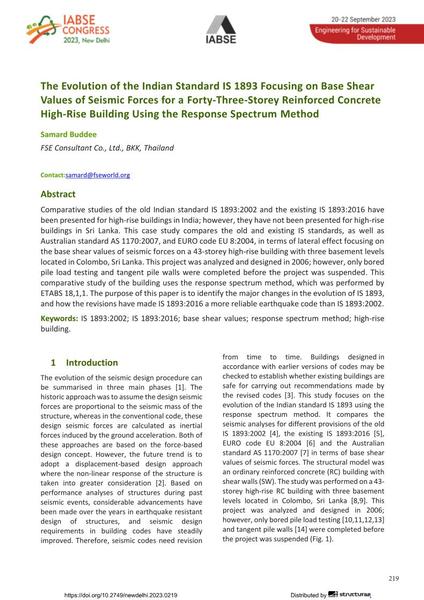The Evolution of the Indian Standard IS 1893 Focusing on Base Shear Values of Seismic Forces for a Forty-Three-Storey Reinforced Concrete High-Rise Building Using the Response Spectrum Method

|
|
|||||||||||
Bibliographic Details
| Author(s): |
Samard Buddee
(FSE Consultant Co., Ltd., BKK, Thailand)
|
||||
|---|---|---|---|---|---|
| Medium: | conference paper | ||||
| Language(s): | English | ||||
| Conference: | IABSE Congress: Engineering for Sustainable Development, New Delhi, India, 20-22 September 2023 | ||||
| Published in: | IABSE Congress New Delhi 2023 | ||||
|
|||||
| Page(s): | 219-226 | ||||
| Total no. of pages: | 8 | ||||
| DOI: | 10.2749/newdelhi.2023.0219 | ||||
| Abstract: |
Comparative studies of the old Indian standard IS 1893:2002 and the existing IS 1893:2016 have been presented for high-rise buildings in India; however, they have not been presented for high-rise buildings in Sri Lanka. This case study compares the old and existing IS standards, as well as Australian standard AS 1170:2007, and EURO code EU 8:2004, in terms of lateral effect focusing on the base shear values of seismic forces on a 43-storey high-rise building with three basement levels located in Colombo, Sri Lanka. This project was analyzed and designed in 2006; however, only bored pile load testing and tangent pile walls were completed before the project was suspended. This comparative study of the building uses the response spectrum method, which was performed by ETABS 18,1,1. The purpose of this paper is to identify the major changes in the evolution of IS 1893, and how the revisions have made IS 1893:2016 a more reliable earthquake code than IS 1893:2002. |
||||
| Keywords: |
high-rise building response spectrum method IS 1893:2002 IS 1893:2016 base shear values
|
||||
